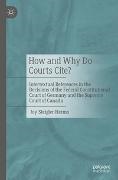Read more
Court decisions can neither be made nor drafted without references to other texts; citations are omnipresent in judicial rulings. Every decision takes relevant normative texts or precedents into account, primarily to ensure coherent case law. Through the act of referencing, courts demonstrate that their decisions are based on an established legal doctrine. This integration into the existing doctrine legitimizes the decision and thus creates legal certainty through predictability.
Moreover, court decisions also contain references to texts that do not possess legal authority and therefore cannot be assigned such a function. Among the sources cited by courts, alongside statutory texts, are—for example—references to foreign law, scholarly sources, or even literary texts.
In view of this, the present study addresses the question of how and why courts cite. Using decisions from the Federal Constitutional Court of Germany and the Supreme Court of Canada as examples, the interdisciplinary study proposes both philological and legal evaluation criteria for the empirical reconstruction of citation functions and furthermore adopts a comparative perspective on jurisdiction-related differences in citation practices in courts.
Joy Steigler-Herms is a research associate in subproject B02, “How and Why Do Courts Cite? Citations and References in Judgments of the Federal Constitutional Court and the Supreme Court of Canada,” at the Collaborative Research Center 1385 “Law and Literature” at the University of Münster.
The translation was done with the help of artificial intelligence. A subsequent human revision was done primarily in terms of content.
This book is a translation of an original German edition. The translation was done with the help of artificial intelligence (machine translation by the service DeepL.com). A subsequent human revision was done primarily in terms of content, so that the book will read stylistically differently from a conventional translation.

